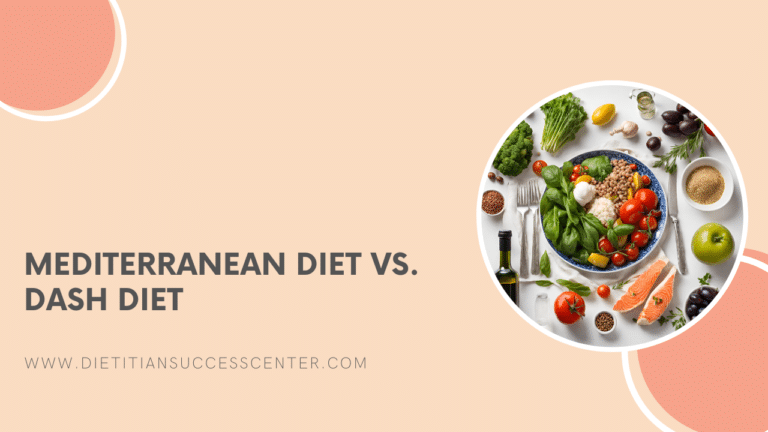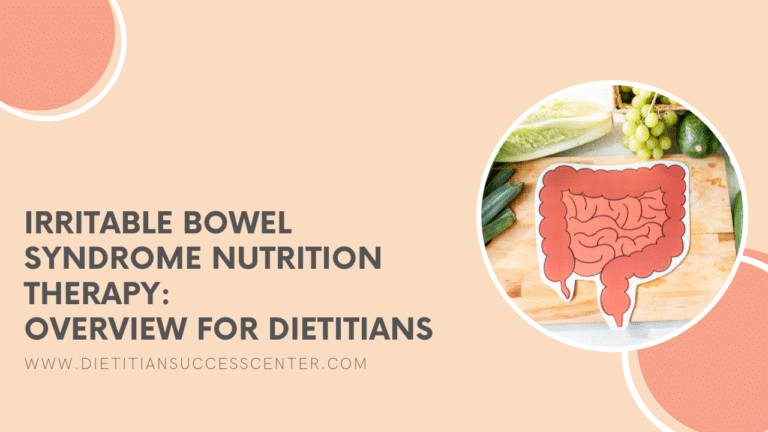

Written by Olivia Farrow, RD, MHSc
Reviewed by Krista Kolodziejzyk, RD, MPH, MBA
Are you a registered dietitian (RD) wanting to learn more about infant feeding? In this article, we share the basics of nutrition for babies based on DSC’s pediatric nutrition course.
The Dietitian Success Center membership includes access to two pediatric nutrition courses: the Infant Feeding Course and Baby Led Weaning course. Learn even more about nutrition for babies, build your expertise, and get access to ready-to-use resources.
Why is this topic important for dietitians?
Whether you want to specialize as a pediatric dietitian, start a private practice as a dietitian for babies, work with families, or feel confident with feeding your own children, a background in infant nutrition is very valuable for dietitians.
Here’s why:
-
- Infancy is a critical time for optimal nutrition, where nutrient deficiencies can impact long-term health and development.
Note: when working with families, it’s important to identify their preferred language when referring to breastfeeding, chestfeeding or bodyfeeding. Chestfeeding and bodyfeeding are terms used by those who do not identify their anatomy with the term “breast”. For the purpose of this article, we will use the terms interchangeably.
Nutrition from the Start
The World Health Organization, Academy of Breastfeeding Medicine and many national health organizations recommend exclusive breastfeeding from birth to 6 months old when complementary foods may be introduced and non-exclusive breastfeeding to 24 months of age and beyond (8). Not every infant is able to be breastfed and some caregivers may choose not to breastfeed, in which case infant formula would be a breastmilk substitute or supplement for babies under 12 months old (10,11).
For most healthy term infants, a basic iron-fortified cow’s milk based formula is suitable which is modeled after breastmilk and has the same energy density at 20 calories per ounce. Despite extensive marketing by formula companies, basic formulas are usually equal in quality and nutritional composition, so cost is likely the most significant determining factor for families (10).
Breastfeeding is covered in more detail in the Dietitian Success Center Breastfeeding course.
Healthcare providers can play a key role in supporting breastfeeding and helping find suitable alternative options for families that are unable to breast/chest/bodyfeed.
Starting Solid Foods
Introduction to foods starts around 6 months. The food a baby eats between 6-12 months is often called “complementary foods” because the food is complementary to breastmilk or formula which is still providing a large portion of the infant’s nutritional needs.
Instead of looking for a date on the calendar, parents and caregivers can look for the following signs of readiness for starting complementary foods (9):
-
- Baby can sit upright: oral motor ability and swallowing is related to head, neck, trunk muscles (many babies are able to sit with minimal or no assistance around 6 months old).
-
- Baby can bring their hands and toys to their mouth.
-
- Interest in food is important but is not a physiologic sign of readiness.
Starting complementary feeding before 4 months old is not recommended. For infants at high risk of food allergies, introducing peanut and egg between 4-6 months may reduce the risk of developing food allergies (10). Learn more about introducing common allergens to babies in DSC’s pediatric nutrition courses.
Texture Progression
When a baby is around 6 months old and sitting upright, caregivers can offer a variety of textures, including mashed, pureed, and soft finger foods. Caregivers can start out spoon-feeding or infants can feed themselves.
When using a baby-led weaning approach to starting complementary foods, the infant primarily feeds themselves with soft finger foods rather than being spoon-fed by a caregiver.
If food is introduced to a baby before 6 months old, it should be pureed and offered on a spoon.
Texture progression should happen quickly.
-
- Delaying the introduction of lumpy textures and sticking with a puree-only diet past 9 months can result in feeding challenges (11).
-
- If caregivers prefer to start with purees, encourage progression to lumpy textures and self-feeding of soft finger foods around 6-9 months old.
-
- Starting with purees may be indicated for babies at risk of dysphagia
DSC’s pediatric nutrition courses walk you through the ideal textures for complementary foods including baby eating video examples in our Baby Led Weaning Course.
First Foods for Babies
When starting complementary foods, the focus should be on providing small amounts of iron-rich and calorie-dense foods (12). Including babies at the table and offering the same foods the family is eating can help babies feel more comfortable and confident with eating family foods.
One meal per day is sufficient for a 6-month-old. This can increase gradually to three meals per day by 9 months old as a baby becomes more interested and involved in family meals.
Why iron-rich first foods?
Though breastmilk or formula is still the main source of nutrition for a 6 to 12-month-old, they cannot meet a baby’s total iron needs (13, 14).
A baby’s iron stores from birth deplete around 6 months old, so introducing iron-rich complementary foods is important to ensure babies have their iron-needs met and can grow and develop appropriately (12,14).
Infants that may be at a higher risk of iron-deficiency include:
-
- Infants with low birth weight
-
- Those born to iron-deficient mothers, mother’s with diabetes, or mother’s who consumed excess alcohol during pregnancy
Delayed cord clamping at birth can help to improve iron stores.
Iron can come from meat or plant-based food sources including iron-fortified infant cereal (15). Small amounts of meat can contribute to iron intake as heme iron (the form of iron found in meat) has better absorption and can improve the absorption of nonheme iron (the form of iron found in plants) (15, 16).
Examples of iron-rich complementary foods:
-
- Soft cooked beef and moist, minced ground beef
-
- Mashed or soft strips of salmon and sardine
-
- Iron-fortified infant cereal
-
- Lentils, beans, and tofu
Vitamin C-rich foods can help improve the absorption of iron from plant-based foods (17).
Vitamin C-rich complementary food examples:
-
- Soft-steamed broccoli
-
- Tomato, mashed, sauce or thin slices
-
- Very ripe papaya, thin strips or mashed
-
- Soft strips or mashed avocado
Why calorie-dense first foods?
As complementary foods may replace breast milk intake, and therefore total caloric intake, foods offered should be energy-dense (13, 14). Adding fat from cooking oils, full-fat yogurt and cheese, and nuts and seeds (ground, thinly spread, or diluted) can help increase the caloric density of complementary foods.
Find more examples in DSC’s pediatric nutrition courses.
Responsive Feeding
Responsive feeding essentially means the caregiver is responsive to the baby’s own hunger and fullness cues and interest in food. Responsive feeding encourages a healthy relationship with food even before the first bite. The caregiver can: let the infant decide how much to eat without pressure, create a calm connected mealtime environment, and allow the baby to eat in a developmentally appropriate way.
Responsive feeding encourages:
-
- Autonomy
-
- Healthy eating patterns
-
- Eating skills
-
- Self-regulation of food
-
- A trusting relationship with the caregiver and food
Foods to Avoid for Infants
-
- Honey, due to the risk of infant botulism
-
- Raw/undercooked meats and fish, which pose a food safety risk for infants
-
- Cow’s milk as a beverage, which can decrease iron absorption and cause intestinal bleeding
-
- Low-fat or diet foods are not calorically dense enough for babies
-
- Excess salt and added sugars, including heavily processed foods
(8)
Key Takeaways
-
- Babies can start eating complementary foods when showing signs of readiness, including sitting upright
-
- Iron-rich and calorie-dense foods make ideal first foods
-
- Responsive feeding can help set babies up for a healthy relationship with food
Disclaimer: the information provided is not intended as medical advice or to diagnose or treat a medical disease. It is strictly for informational purposes. DSC is not liable for any action taken based on the content in this article. Consult with your medical provider before implementing any dietary changes, the information provided does not replace medical advice provided by your healthcare provider.
At DSC, we make it easier for dietitians and dietetic students to build expertise in various areas of practice including pediatric nutrition course and infant feeding topics. Our pediatric nutrition courses, ready-to-use client handouts, and community can help you feel more confident supporting your youngest clients!
Dietitian Success Center is THE professional development resource for dietitians and dietetic students. Our mission is to make it easier for dietitians and dietetic students to build expertise. We do this through evidence-based online nutrition courses, community and ready-to-use client handouts. Plus – we give you the tools to start and grow your dietitian private practice!
References:
1. Ahern, Sara M., Samantha J. Caton, Sofia Bouhlal, Helene Hausner, Annemarie Olsen, Sophie Nicklaus, Per Møller, and Marion M. Hetherington. 2013. “Eating a Rainbow. Introducing Vegetables in the First Years of Life in 3 European Countries.” Appetite 71 (December): 48–56. https://doi.org/10.1016/j.appet.2013.07.005.
2. Anzman, S L, B Y Rollins, and L L Birch. 2010. “Parental Influence on Children’s Early Eating Environments and Obesity Risk: Implications for Prevention.” International Journal of Obesity 34 (7): 1116–24. https://doi.org/10.1038/ijo.2010.43.
3. Mennella, Julie A., Sophie Nicklaus, Amanda L. Jagolino, and Lauren M. Yourshaw. 2008. “Variety Is the Spice of Life: Strategies for Promoting Fruit and Vegetable Acceptance during Infancy.” Physiology & Behavior 94 (1): 29–38. https://doi.org/10.1016/j.physbeh.2007.11.014.
4. Picciano, Mary Frances, Helen Smiciklas-Wright, Leann L. Birch, Diane C. Mitchell, Laura Murray-Kolb, and Kristen L. McConahy. 2000. “Nutritional Guidance Is Needed During Dietary Transition in Early Childhood.” Pediatrics 106 (1): 109–14. https://doi.org/10.1542/peds.106.1.109.
5. World Health Organization 2001. “Global strategy for infant and young child feeding. The optimal duration of exclusive breastfeeding”. May 2001.
6. Chouraqui, Jean-Pierre, Bérénice Delmas, Marine Le Bris, Marc Bellaiche, Camille Jung, and Thierry Hanh. 2019. “Physicians Advice, Parental Practice and Adherence to Doctor’s Advice: An Original Survey on Infant Feeding.” BMC Pediatrics 19 (1). https://doi.org/10.1186/s12887-019-1697-y.
7. Synnott, K, J Bogue, C A Edwards, J A Scott, S Higgins, E Norin, D Frias, S Amarri, and R Adam. 2007. “Parental Perceptions of Feeding Practices in Five European Countries: An Exploratory Study.” European Journal of Clinical Nutrition 61 (8): 946–56. https://doi.org/10.1038/sj.ejcn.1602604.
8. World Health Organization and UNICEF. 2003. “Global strategy for infants and young child feeding”. Geneva: World Health Organization.
9. Naylor, Audrey J., Ardythe L. Morrow, and Armond S. Goldman. 2001. Developmental readiness of normal full term infants to progress from exclusive breastfeeding to the introduction of complementary foods: reviews of the relevant literature concerning infant immunologic, gastrointestinal, oral motor, and maternal reproductive and lactational development. Washington, DC: Linkages Project.
10. Du Toit, George, Graham Roberts, Peter H Sayre, Henry T Bahnson, Suzana Radulovic, Alexandra F Santos, Helen A Brough, et al. 2015. “Randomized Trial of Peanut Consumption in Infants at Risk for Peanut Allergy.” The New England Journal of Medicine 372 (9): 803–13. https://doi.org/10.1056/NEJMoa1414850.
11. Coulthard, Helen, Gillian Harris, and Pauline Emmett. 2009. “Delayed Introduction of Lumpy Foods to Children during the Complementary Feeding Period Affects Child’s Food Acceptance and Feeding at 7 Years of Age.” Maternal & Child Nutrition 5 (1): 75–85. https://doi.org/10.1111/j.1740-8709.2008.00153.x.
12. Dewey, Kathryn G, and Camila M Chaparro. “Session 4: Mineral metabolism and body composition iron status of breast-fed infants.” The Proceedings of the Nutrition Society vol. 66,3 (2007): 412-22. doi:10.1017/S002966510700568X
13. Pan American Health Organization. (2003). “Guiding principles for complementary feeding of the breastfed child.”
14. Butte, Nancy, Kathleen Cobb, Johanna Dwyer, Laura Graney, William Heird, and Karyl Rickard. 2004. “The Start Healthy Feeding Guidelines for Infants and Toddlers. Journal of the American Dietetic Association.” Journal of the American Dietetic Association 104 (3): 442–54. https://doi.org/10.1016/j.jada.2004.01.027.
15. Hambidge, K Michael, Xiaoyang Sheng, Manolo Mazariegos, Tianjiang Jiang, Ana Garces, Dinghua Li, Jamie Westcott, et al. 2011. “Evaluation of Meat as a First Complementary Food for Breastfed Infants: Impact on Iron Intake.” Nutrition Reviews 69 (1): S57–63. https://doi.org/10.1111/j.1753-4887.2011.00434.x.
16. Engelmann, Mads D M, Lena Davidsson, Brittmarie Sandström, Thomas Walczyk, Richard F Hurrell, and Kim F Michaelsen. 1998. “The Influence of Meat on Nonheme Iron Absorption in Infants.” Pediatric Research 43 (6): 768–73. https://doi.org/10.1203/00006450-199806000-00009.
17. Hurrell R, Egli I. Iron bioavailability and dietary reference values. Am J Clin Nutr. 2010 May;91(5):1461S-1467S. doi: 10.3945/ajcn.2010.28674F. Epub 2010 Mar 3. PMID: 20200263.
18. Satter, Ellyn. 2000. Child of Mine : Feeding with Love and Good Sense. Palo Alto, Calif.: Bull Pub. ; Berkeley, Ca.
19. Black, Maureen M., and Frances E. Aboud. 2011. “Responsive Feeding Is Embedded in a Theoretical Framework of Responsive Parenting.” The Journal of Nutrition 141 (3): 490–94. https://doi.org/10.3945/jn.110.129973.








